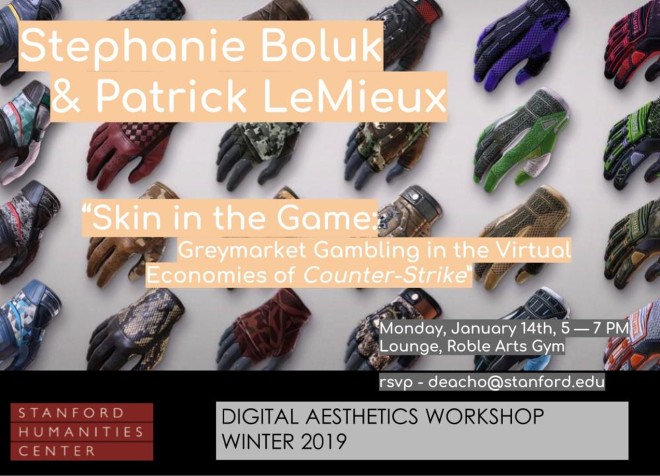
Next Monday (January 14, 2018), we will be joined at the Digital Aesthetics Workshop by Stephanie Boluk & Patrick LeMieux. They are coming to us from UC-Davis, where Stephanie is Associate Professor of English and of Cinema and Digital Media, and where Patrick is Assistant Professor of Cinema and Digital Media. Boluk & LeMieux are scholars, critics, and artists who work largely around videogames and digital art. Their book Metagaming (Minnesota, 2017) wrenches open the ‘texts’ of videogames to consider them as tools, materials, platforms, and stages for all sorts of new social practices – it is easily one of the best works in game studies yet published. They have also co-created several critical games of their own that you can easily run on your laptop.
On Monday, they will be sharing in-progress material from their next book project, Money Games. Join us on Monday, January 14, 2018 (5-7pm in the Roble Arts Gym Lounge), and RSVP if you can! There will not be pre-circulated reading, though their games are recommended.
Here is the blurb for the event:
In 1987, a pyramid scheme called the “Plane Game” funneled hundreds of thousands of dollars from the pockets of “passengers,” landing at least six of the game’s “pilots” in jail. In 2018, more ubiquitous moneygames are played with smaller stakes across far wider fields. From the Valve Corporation’s Flatland to grey market gambling with Counter-Strike gun skins, this talk will move from from the Steam Workshop to the Steam Marketplace to series of third-party websites that explore the way in which money operates as a game mechanics and how game mechanics have come to operate as money. Although strict distinctions are made between gambling and gaming in both US law as well as 20th century philosophies of games and play, these terms’ etymological roots are tightly wound. In a post-2008 age of precarity, the wage has once again become a wager. In 2012, Alex Galloway proclaimed “we are all goldfarmers,” but gun skins and skin gambling represent an even more complex and complete financialization in that players have moved from one mode in which labour time is exchanged for a clear wage (even if it’s grinding in World of Warcraft) to one in which labour time itself becomes a wager. Ultimately skins are not simply texture files that wrap around the polygonal geometry of virtual weapons. Instead, they are objects of affinity and status, digital cash and casino chips, and a gun skins’ procedurally generated pattern, determined by a 9-digit floating point number selected upon unboxing, is more cryptocurrency than art asset. In this talk we follow the money, the skin, the flow, and the flight of new “plane games” as metagames become moneygames.